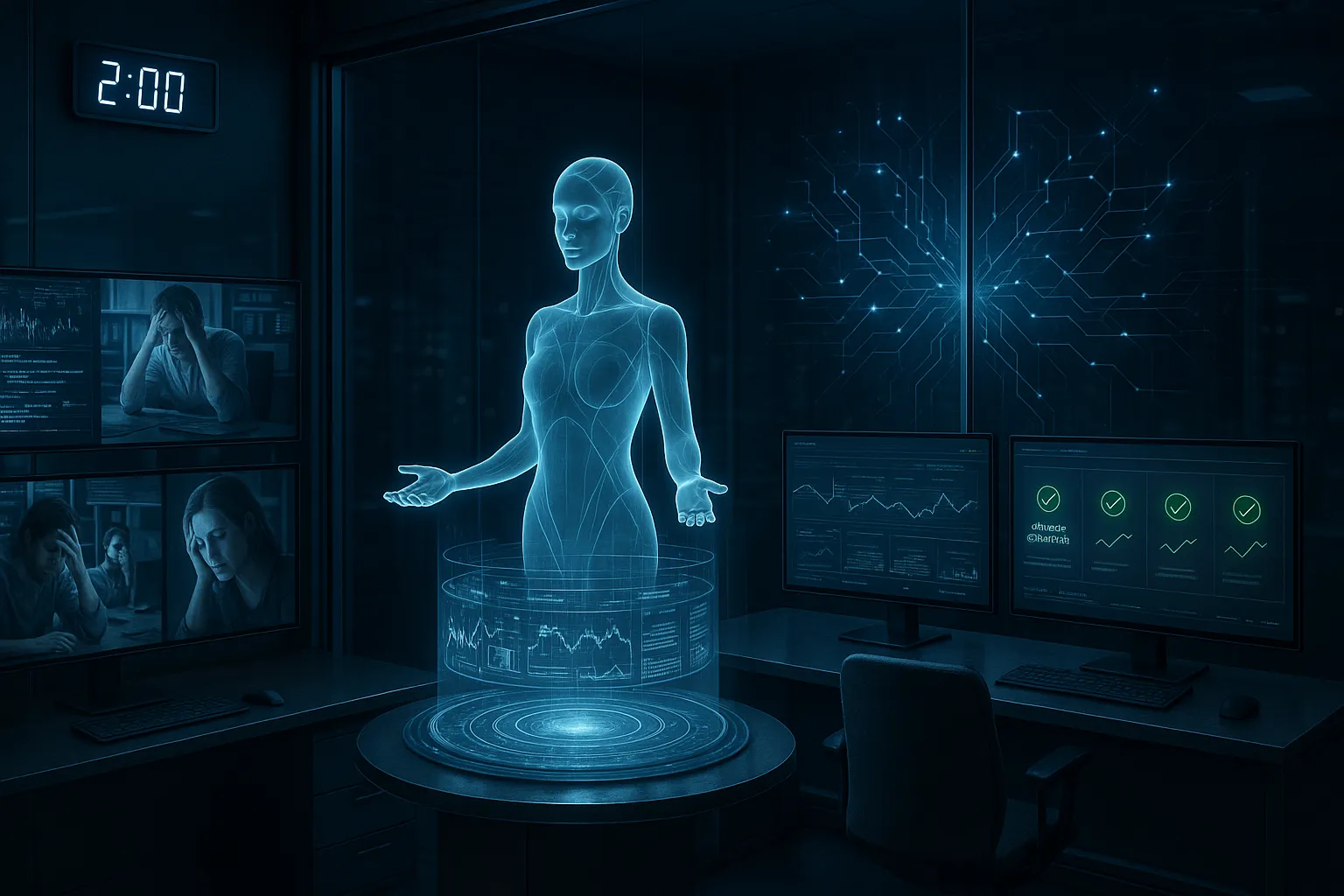💡 TL;DR - The 30 Seconds Version
💰 Ciroos.AI raised $21 million to build AI that cuts system outage response time by 90% for operations teams.
👥 Three former Cisco executives founded the company in February 2025, bringing 84 patents in AI and networking.
🤖 The AI uses multi-agent systems to investigate problems across hundreds of tools before human engineers get alerted.
⏱️ What typically takes 2 hours to diagnose and fix now happens in minutes through automated reasoning and response.
🏢 Energy Impact Partners led the funding round as enterprises struggle with growing IT complexity and 2 AM emergency calls.
🚀 This marks a shift from monitoring tools that add more data to AI that makes sense of existing information.
Ciroos.AI emerged from stealth mode with $21 million in funding and a promise to fix one of technology's most persistent problems: the dreaded middle-of-the-night emergency call.
The startup's AI-powered "SRE Teammate" cuts incident response time by 90 percent. What used to take hours now takes minutes. What used to wake entire teams at 2 AM might not wake anyone at all.
Energy Impact Partners led the Series A round. The company plans to use the funding to hire engineers and expand sales operations.
Three former Cisco executives founded Ciroos in February. CEO Ronak Desai previously ran Cisco's AppDynamics observability unit. CTO Amit Patel and Chief Product Officer Ananda Rajagopal also came from Cisco's networking and cloud divisions. The trio holds 84 patents across AI, observability, and distributed systems.
The Problem Gets Worse
Modern enterprise systems span dozens of applications, hundreds of tools, and multiple cloud environments. When something breaks, site reliability engineers scramble across dashboards, logs, and monitoring systems to find the root cause.
Desai saw this firsthand at Cisco. Customers complained about managing hundreds of tools without connected insights. Teams spent hours correlating data across network, security, and application domains. Some problems lurked undetected for months.
"On average, it takes about two hours to investigate and figure out where the problem is," Desai said. "At times, we've seen it take days."
The cognitive load overwhelms human operators. War room calls drag on. Engineers dive through dashboard after dashboard. Sleep becomes a luxury.
Multi-Agent Architecture
Ciroos built its solution around multi-agent AI systems. Different agents specialize in network equipment, security tools, cloud services, and applications. They work together to correlate data and identify problems.
The system uses the Model Context Protocol and Agent-to-Agent architectures. It integrates with existing tools from Datadog, Prometheus, Jira, and Slack rather than replacing them.
"Can I have a network agent which has expertise on your Nexus equipment? Can I have an agent with expertise around your security domains? Can I build capability with expertise on your cloud services?" Desai explained. "That's where it becomes important, because you have so many different tools."
The AI starts investigating anomalies before human experts get paged. It uses reasoning models to understand cross-domain interactions and separate real problems from false alarms.
Beyond Chat Interfaces
Ciroos positions itself differently from observability vendors adding AI chat features. Instead of providing natural language interfaces over existing APIs, the company built a reasoning engine that mimics human decision-making.
"Our system doesn't just provide a UI on top of APIs," Desai said. "It correlates live and historical data, connects across systems and can recommend or even execute actions such as restarting services or rolling back deployments."
The platform supports semi-automated responses like triggering Git-based rollbacks. It also offers "autopilot" mode for full automation where customers feel comfortable with autonomous fixes.
Competition With Manual Labor
Desai frames the main competition as manual labor, not existing monitoring tools. The company integrates with the observability ecosystem rather than disrupting it.
"We do not compete with any of the observability tools," he said. "We are competing with manual labor and the toil SREs have. They are looking at hundreds of dashboards and trying to figure everything out and the cognitive load is too much for humans."
The approach wouldn't have worked with earlier AI models. Recent advances in reasoning capabilities made cross-domain correlation possible at enterprise scale.
Timing and Technology
The company's timing aligns with broader enterprise AI adoption. As organizations deploy more AI agents, operational complexity increases. Traditional monitoring approaches struggle to keep pace.
Ciroos leverages whatever new model advances emerge. The platform's extensible architecture adapts to new technologies and integrates with customer-developed agents.
"Out of the box, we built agent-to-agent capability where we can hook into an agent that the customer has deployed or developed on their own," Desai said.
Go-to-Market Strategy
The startup focuses on direct enterprise sales. It experiments with value-based pricing rather than traditional volume-based models common in observability.
Desai emphasizes partner relationships, drawing from his Cisco background. "Coming from Cisco, partners are close to my heart," he said. The company actively recruits channel partners.
Early customers work with Ciroos to build out the platform's multi-domain knowledge. The company invites other early adopters while preparing for broader launch.
Return on Investment
Desai jokes that sleep is the best measure of uptime for SREs. The real ROI comes from eliminating manual work that humans shouldn't handle.
Cutting investigation windows from hours to minutes transforms operations. Teams avoid lengthy war room calls. Engineers spend less time diving through dashboards. Organizations reduce the human cost of maintaining complex systems.
"We're really looking to avoid that manual toil and the tasks which we do not want our human SREs to do," Desai said.
Market Opportunity
The observability market continues growing as enterprises adopt cloud-native architectures. Organizations typically use 50 different monitoring and incident response tools. Each adds complexity without solving the correlation problem.
Ciroos addresses gaps that traditional observability vendors miss. Instead of adding more data sources, it makes sense of existing information. Instead of more dashboards, it provides automated analysis.
The approach recognizes that modern IT operations exceed human cognitive limits. No amount of training or tooling can help a single engineer correlate hundreds of data streams in real time during a critical outage.
What Comes Next
Ciroos builds toward general availability while expanding its agent capabilities. The company focuses on problems that matter to large enterprises rather than trying to solve everything at once.
The founders understand enterprise software cycles. They've seen technologies promise to revolutionize operations only to create new problems. Their approach emphasizes augmenting human teams rather than replacing them.
"The goal is to reduce human toil from SREs so that we can give them the sleep and time back and build a scalable system," Desai said.
The company's success will depend on execution rather than technology alone. Enterprise customers need proof that AI can handle their most critical systems. Trust builds slowly in operations, where mistakes cost millions.
But the problem is real. The technology seems ready. And the team has credentials that open enterprise doors.
Why this matters:
- Modern IT complexity has outpaced human ability to manage it effectively – Ciroos represents a shift from adding more monitoring tools to actually making sense of the data we already collect.
- This signals the maturation of AI from chatbots to mission-critical infrastructure management, where getting it wrong costs millions and getting it right saves careers.
❓ Frequently Asked Questions
Q: How much does Ciroos actually cost for enterprises?
A: Ciroos hasn't released specific pricing yet. The company experiments with value-based pricing instead of traditional volume-based models used by observability platforms. Early adopters are working directly with Ciroos to establish pricing as the company prepares for general availability.
Q: What exactly are the 84 patents that the founding team holds?
A: The three founders collectively hold 84 patents across AI, observability, distributed systems, cloud computing, cybersecurity, and networking. These come from their years at Cisco, AWS, Gigamon, and Brocade, where they built enterprise networking and monitoring systems.
Q: Does the AI actually fix problems automatically or just identify them?
A: Both. The system offers semi-automated responses like triggering Git-based rollbacks and restarting services. It also supports full "autopilot" mode for autonomous fixes where customers feel comfortable. Users control how much automation they want.
Q: What's the difference between Model Context Protocol and Agent-to-Agent architectures?
A: Model Context Protocol lets Ciroos's internal AI agents communicate with each other to share information. Agent-to-Agent architecture allows integration with third-party or customer-developed AI agents. Together, they create a flexible foundation for connecting different AI systems.
Q: How many enterprise customers is Ciroos working with currently?
A: Ciroos works with early adopters but hasn't disclosed specific customer numbers. The company launched from stealth in June 2025 and focuses on building out the platform with select enterprises before general availability.








